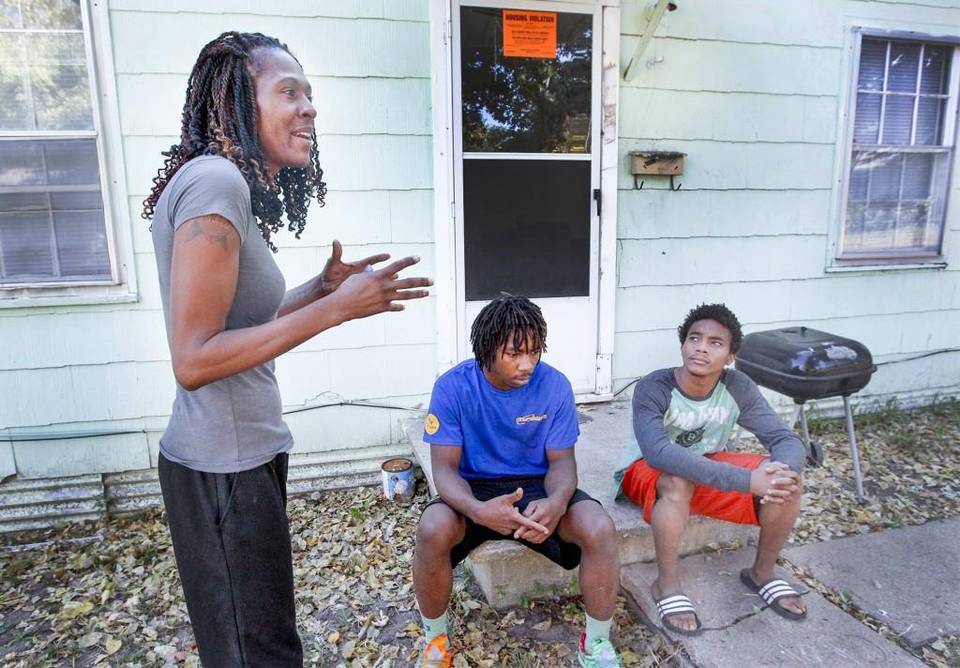For months, the county had failed to pay its electric bill.
Now, the power was going to be shut off.
Citizens coming to pay their taxes were being told they couldn’t, and they were asked to leave the building. For many, the incident revealed that something was amiss in Clay County government.
“It’s like when you break out in a rash,” said Clay County Collector Lydia McEvoy, one of the officials who worked with the power company to keep the lights on that day, even though her job does not include paying the electric bill. “It revealed something’s going on underneath, what we’d expected and suspected all along.
“This is not normal.”
Although county officials were eventually able to negotiate a way to keep the lights on, the incident caught the attention of Clay County resident Jason Withington, who wanted to know more. How does this happen? Was something bigger going on than a couple of missed invoices?
In a bipartisan, grassroots effort led by Withington, Clay County residents have been collecting signatures for a petition.
The goal: a state audit of Clay County government.
The idea was sparked by the electric bill issue but was sustained by a multitude of other incidents in the last year: a charge of tampering with a public record by a county employee, leading to allegations of department budget and staff cuts as retaliation; the hiring of multiple law firms for hundreds of thousands of dollars; invoices for $600 coffeepots; changes to the county’s sunshine request process; verbal in-fighting among its three commissioners; and, more recently, allegations of physical assault by county employees toward a petitioner.
Now, citizens are leading the charge to hold their local government accountable. The petition highlights not only a divide between citizens and their government but a divide among county officials themselves, with some signing it, like McEvoy, and others rebuking it.
“I hope it will restore faith and trust in our county government that’s been lacking for a long time,” Withington said.
According to the state auditor’s office, Clay County citizens need to submit at least 5,590 valid signatures for the audit to take place. They’ve already surpassed that by several thousand signatures.
Withington says he’s gotten pushback from some county officials, including what he calls an intimidation letter after he circulated emails about upcoming meetings about the petition.
The letter, from the county’s legal counsel, claims Withington’s emails too closely resembled official county meeting notices. The letter said that if Withington did not stop circulating the emails, the county would “evaluate all legal options.”
“They are fighting this audit very hard,” he said. “I don’t know what they’re worried about, but they’re fighting this.”
‘Political witch hunt’
This year, the Missouri State Auditor’s Office has received more than a dozen whistleblower contacts related to Clay County. If the petition is successful, the office can begin a performance audit that would not only look into the county’s financial records but also its processes and specific concerns brought forward by whistleblowers.
The county was last audited by the state in 1990 at the request of the County Commission.
But this time around, two of the three commissioners — the two who are not up for re-election this fall — are against it.
Commissioner Gene Owen, a Democrat, said he believes the petition is “all political. It’s a political witch hunt.”
“Some opponents out there, the ones who stir up controversy, try to bring up these issues that aren’t an issue, only in their own mind. And so they’re trying to bring up controversy for election purposes. That’s too bad. I mean, if it costs the county any money, it’s ridiculous.”
The audit is estimated to cost $100,000 to $150,000, according to State Auditor Nicole Galloway, and may take up to a year to complete.
Another commissioner, Luann Ridgeway, a Republican and former Missouri legislator, said she believes the audit is too costly for the county, which would pick up the tab.
“The people who are promoting the audit are long on rhetoric, they’re short when it comes time to say where they will make the cuts to pay for this,” Ridgeway said.
“If it costs an estimate of $100,000 to $150,000 for the auditor to ask the questions and distill information, the taxpayers have to understand that it’s only reasonable to assume that you can double that with regard to our cost to find the answers accurately and timely. So when we say that at a minimum it would cost the taxpayers of Clay County over $300,000 for this audit, that’s not a figment of anyone’s imagination. That’s a fact.”
Galloway says her estimates are based on the costs for audits done for other counties of similar size and scope.
Record tampering
In January 2017, County Clerk Megan Thompson was processing invoices when she noticed the signatures of another commissioner, Jerry Nolte, had been cut off of documents. At the time, she said, the invoices needed two of three commissioners to sign off on them.

So Thompson immediately notified the Sheriff’s Department, which notified the Missouri Attorney General’s Office, which asked the criminal investigations unit of the Missouri Highway Patrol to look into the incident.
Those events led to the charge of tampering with public records by assistant county administrator Laurie Portwood, who later reached an agreement with the attorney general to defer prosecution for two years if she agrees to not tamper with other government documents in the future and complete 40 hours of community service.
Portwood is still employed by the county and makes $107,879 a year, according to the Clay County Transparency Portal.
After the signature ordeal, the County Commission voted 2-1 (Ridgeway and Owen against Nolte) to remove Thompson as custodian of records and give that title to the county administrator, Dean Brookshier.
“I was told that, when I was still custodian of records, that I was giving away information and I was not charging enough for it and I was making it too public, which seems like the exact opposite of what county government should do,” said Thompson, a Republican who is up for re-election this fall and who signed the petition.
“If there was a fee associated, like if there was time to gather the documents, I wouldn’t charge that. I’m an elected official, and I’m here to work for you. I don’t feel like you need to pay me additional money to do my job.”
Ridgeway contends that Thompson was removed as custodian for “politicizing the process and was being woefully inadequate in responding to sunshine requests that citizens needed to know.”
The door outside Thompson’s office at the Clay County Courthouse still says “Custodian of Records.” She hasn’t removed the words, she said, because she still hopes someday she’ll get that title back. Since she was removed as records custodian, the county has paid more than $57,000 to the law firm Spencer Fane to process all of its sunshine requests, according to county records provided to The Star.

Then in November, when elected officials in the county were asked to vote on their own pay increases — including a more than 20 percent pay increase for the commissioners — Thompson voted no.
In December, her budget was cut by a third in another 2-1 vote by the commission, forcing her to fire two employees in the clerk’s office. Now, she said, her office doesn’t have enough funding to get through the rest of the year.
“It’s hard to come to any other conclusion that this isn’t some sort of retaliation for me doing my job,” Thompson said.
It wasn’t just Thompson’s budget that was cut. Nearly $1 million was cut from Sheriff Paul Vescovo’s department as well in budget meetings that Vescovo said he could “only describe as hostile.”
“The only two offices that were severely cut were the clerk and sheriff,” said Vescovo, who is in his fourth term as sheriff and who has signed the petition.
“I can’t help but feel that it was retaliation for the initial investigation and my doing my due diligence as chief law enforcement officer of Clay County. … I’ve seen different commissions come and go. There are always going to be disagreements, but never in the time I’ve spent here as sheriff have I seen it this bad.”
‘This is not right’
Nolte, a Republican who is up for re-election this fall, is used to being the odd man out: Not only is he usually the lone “No” vote on county agenda items, he’s also the only commissioner who has signed the petition.
“I recognized that it was a legitimate expression of the will of the people, and I wanted to be part of it,” he said. “My job is not to make things easy for the government. My duty is to make things right for the people, and this is not right.”
There are a lot of things happening in Clay County government, he said, and as an elected official, he should know about them. But there’s been a veil of secrecy over how some things have been handled in the county, he said, particularly since the commission (in a 2-1 vote) ceded power to the unelected county administrator last year.
Now Nolte said he has to file sunshine requests to an outside law firm in order to get information from the government he was elected to run. He’s paid about $100 for the records. But it’s not the amount, he said. It’s the principle.
“I asked that I would like the charges waived in the course of doing my duties as presiding commissioner, and it was denied,” he said. He wanted to take up the issue in a commission meeting but said that was effectively denied as well since the county administrator now has the sole authority to decide what’s on the agenda.
“We can ask. We cannot demand,” he said.
Another issue Nolte asked to be put on the agenda? Details about why the county didn’t pay the annex electric bill last year. That didn’t happen either.
Another power ceded by the commission to the county administrator was the creation of “official actions” for the county administrator. Those actions would have as much force as a resolution the commission votes on, except they can be executed by the county administrator without notification or approval of the commission.
“There were a lot of questions being asked about a lot of the actions that were taken by the commission on a lot of those 2-1 votes,” Nolte said. “Those questions are no longer asked because those votes are no longer taken.”
Fighting audits
The county hasn’t just pushed back on citizen-initiated audits.
In January, Sen. Bob Dixon of Greene County introduced a bill in the Missouri General Assembly that would allow law enforcement agencies and prosecutors to request an audit by the state auditor.
It passed a Senate committee on Feb. 1. Within a week, Clay County hired lobbyists from Husch Blackwell, according to Missouri Ethics Commission documents, to lobby against the bill. The first name in their group of lobbyists is Andy Blunt, son of U.S. Sen. Roy Blunt.
According to county records provided to The Star, the county paid Husch Blackwell a total of $128,115.99 between February and April of this year, although it’s unclear how much of that went to the lobbyists or the county’s legal counsel.
Either way, it got its money’s worth. The bill didn’t get picked up again in the Senate until April 5, when it passed unanimously, but stalled out in the House with only weeks left in the session.
Since 2016, the county has spent more than $555,000 on outside legal fees with at least 13 law firms, according to county records provided to The Star.
“The number of legal entities we have has increased pretty dramatically,” Nolte said.
And at least one of the firms, Nolte said, helped represent the county employee charged with record tampering on the county’s dime.
“I thought it was bad policy and bad practice for the county to pay for criminal defense of people accused of crimes against the county,” Nolte said. “That seemed like we’re paying both sides. … We committed the county to pay those legal fees, and I objected to it. I think it’s a bad practice.”
More recently, documents provided to The Star show that two other county employees allegedly involved in a physical altercation with a petitioner at the Liberty Lowe’s in May will also have their legal bills paid by the county at a going rate of $400 an hour. Liberty Police say the investigation is ongoing.
‘We have to investigate’
At the end of this month, Withington, the chief petitioner, said he plans to hand a stack of all the gathered petitions to the state auditor. The signatures would then have to be validated by the county clerk’s office.
Galloway said the reports she’s gotten from whistleblowers about Clay County have been concerning, but they “don’t presume to know the facts regarding this information. If your job is to get to the bottom of the issue and to the truth, we have to investigate.”
If they do find fraud or criminal activity, or if the county does not cooperate once the audit is underway, Galloway said her office is prepared to use all legal mechanisms, including subpoenas.
“We don’t know what we’ll find until we actually do the audit.”






